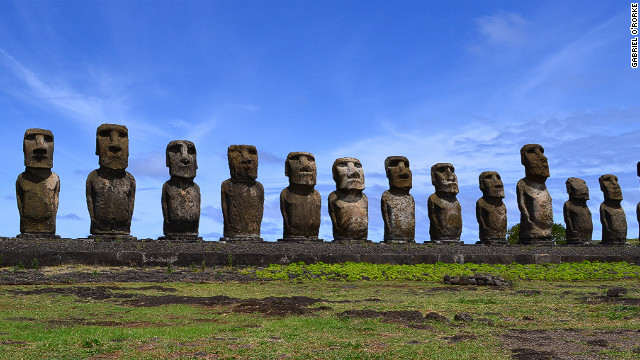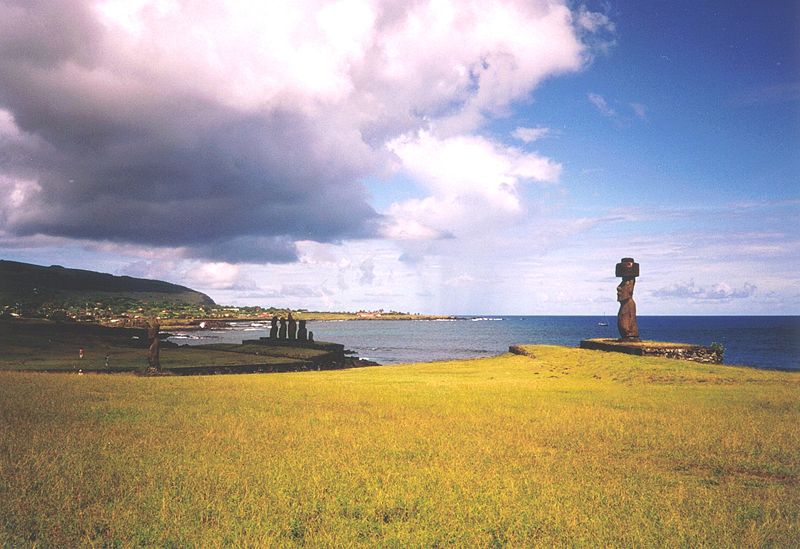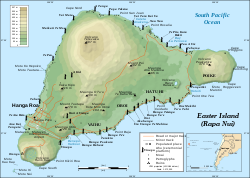
 The English name of the island commemorates its European discovery by a Dutch exploration vessel on Easter Sunday in 1722.
a Polynesian island in the southeastern Pacific Ocean, at the southeasternmost point of the Polynesian Triangle. Easter Island is famous for its 887 extant monumental statues, called moai, created by the early Rapa Nui people.
Easter Island is one of the most remote inhabited islands in the world.[6] The nearest inhabited land (50 residents) is Pitcairn Island at 2,075 kilometres (1,289 mi), and the nearest continental point lies in central Chile, at 3,512 kilometres (2,182 mi).
Easter Island is a special territory of Chile that was annexed in 1888. Administratively, it belongs to the Valparaíso Region and more specifically, is the only commune of the Province Isla de Pascua.[7] According to the 2012 census, it has about 5,800 residents, of which some 60% are descendants of the aboriginal Rapa Nui.
The history of Easter Island is rich and controversial. Its inhabitants have endured famines, epidemics, civil war, slave raids, colonialism, and near deforestation; its population declined precipitously more than once.
Ever since Thor Heyerdahl and a small party of adventurers sailed their raft from South America to the Tuamotu islands, far to the north of Easter Island, a controversy has raged over the origin of the islanders. Today DNA testing has proved conclusively that the Polynesians arrived from the west rather than the east, and that the people of Easter Island are descendants of intrepid voyagers who set out from another island thousands of years ago. Legend says that the people left for Easter Island because their own island was slowly being swallowed by the sea.
In brief, the prehistory of Easter Island is one of supreme accomplishment, flourishing and civilization, followed by environmental devastation and decline. Although it is not agreed when people first arrived on Easter Island (with estimates ranging from several hundred to more than one thousand years ago), consensus seems to be that the first peoples arrived from Polynesia. Rather than being inhabited by mistake or chance, evidence has suggested that Easter Island was colonized deliberately by large boats with many settlers -- a remarkable feat given the distance of Easter Island from any other land in the Pacific Ocean.
The first islanders found a land of undoubted paradise -- archaeological evidence shows that the island was covered in trees of various sorts, including the largest palm tree species in the world, whose bark and wood furnished the natives with cloth, rope, and canoes. Birds were abundant as well, and provided food for them. A mild climate favored an easy life, and abundant waters yielded fish and oysters.
The islanders prospered due to these advantages, and a reflection of this is the religion which sprouted in their leisure, which had at its centrepiece the giant moai, or heads, that are the island's most distinctive feature today. These moai, which the island is littered with, are supposed to have been depictions of ancestors, whose presence likely was considered a blessing or watchful safekeeping eye over each small village. The ruins of Rano Raraku crater, the stone quarry where scores if not hundreds of moai sit today, is a testament to how central these figures were to the islanders, and how their life revolved around these creations. It has been suggested that their isolation from all other peoples fuelled this outlet of trade and creativity -- lacking any other significant way to direct their skills and resources. The bird-man culture (seen in petroglyphs), is an obvious testament to the islanders' fascination with the ability to leave their island for distant lands.
However, as the population grew, so did pressures on the island's environment. Deforestation of the island's trees gradually increased, and as this main resource was depleted, the islanders would find it hard to continue making rope, canoes, and all the necessities to hunt and fish, and ultimately, support the culture that produced the giant stone figureheads. Apparently, disagreements began to break out (with some violence) as confidence in the old religion was lost, and is reflected partly in the ruins of moai which were deliberately toppled by human hands. By the end of the glory of the Easter Island culture, the population had crashed in numbers, and the residents -- with little food or other ways to obtain sustenance -- resorted sometimes to cannibalism and a bare subsistence. Subsequent raids by powers such as Peru and Bolivia devastated the population even more, until only a few hundred native Rapa Nui were left by the last century.
The English name of the island commemorates its European discovery by a Dutch exploration vessel on Easter Sunday in 1722.
a Polynesian island in the southeastern Pacific Ocean, at the southeasternmost point of the Polynesian Triangle. Easter Island is famous for its 887 extant monumental statues, called moai, created by the early Rapa Nui people.
Easter Island is one of the most remote inhabited islands in the world.[6] The nearest inhabited land (50 residents) is Pitcairn Island at 2,075 kilometres (1,289 mi), and the nearest continental point lies in central Chile, at 3,512 kilometres (2,182 mi).
Easter Island is a special territory of Chile that was annexed in 1888. Administratively, it belongs to the Valparaíso Region and more specifically, is the only commune of the Province Isla de Pascua.[7] According to the 2012 census, it has about 5,800 residents, of which some 60% are descendants of the aboriginal Rapa Nui.
The history of Easter Island is rich and controversial. Its inhabitants have endured famines, epidemics, civil war, slave raids, colonialism, and near deforestation; its population declined precipitously more than once.
Ever since Thor Heyerdahl and a small party of adventurers sailed their raft from South America to the Tuamotu islands, far to the north of Easter Island, a controversy has raged over the origin of the islanders. Today DNA testing has proved conclusively that the Polynesians arrived from the west rather than the east, and that the people of Easter Island are descendants of intrepid voyagers who set out from another island thousands of years ago. Legend says that the people left for Easter Island because their own island was slowly being swallowed by the sea.
In brief, the prehistory of Easter Island is one of supreme accomplishment, flourishing and civilization, followed by environmental devastation and decline. Although it is not agreed when people first arrived on Easter Island (with estimates ranging from several hundred to more than one thousand years ago), consensus seems to be that the first peoples arrived from Polynesia. Rather than being inhabited by mistake or chance, evidence has suggested that Easter Island was colonized deliberately by large boats with many settlers -- a remarkable feat given the distance of Easter Island from any other land in the Pacific Ocean.
The first islanders found a land of undoubted paradise -- archaeological evidence shows that the island was covered in trees of various sorts, including the largest palm tree species in the world, whose bark and wood furnished the natives with cloth, rope, and canoes. Birds were abundant as well, and provided food for them. A mild climate favored an easy life, and abundant waters yielded fish and oysters.
The islanders prospered due to these advantages, and a reflection of this is the religion which sprouted in their leisure, which had at its centrepiece the giant moai, or heads, that are the island's most distinctive feature today. These moai, which the island is littered with, are supposed to have been depictions of ancestors, whose presence likely was considered a blessing or watchful safekeeping eye over each small village. The ruins of Rano Raraku crater, the stone quarry where scores if not hundreds of moai sit today, is a testament to how central these figures were to the islanders, and how their life revolved around these creations. It has been suggested that their isolation from all other peoples fuelled this outlet of trade and creativity -- lacking any other significant way to direct their skills and resources. The bird-man culture (seen in petroglyphs), is an obvious testament to the islanders' fascination with the ability to leave their island for distant lands.
However, as the population grew, so did pressures on the island's environment. Deforestation of the island's trees gradually increased, and as this main resource was depleted, the islanders would find it hard to continue making rope, canoes, and all the necessities to hunt and fish, and ultimately, support the culture that produced the giant stone figureheads. Apparently, disagreements began to break out (with some violence) as confidence in the old religion was lost, and is reflected partly in the ruins of moai which were deliberately toppled by human hands. By the end of the glory of the Easter Island culture, the population had crashed in numbers, and the residents -- with little food or other ways to obtain sustenance -- resorted sometimes to cannibalism and a bare subsistence. Subsequent raids by powers such as Peru and Bolivia devastated the population even more, until only a few hundred native Rapa Nui were left by the last century.




http://wikitravel.org/en/Easter_Island
http://en.wikipedia.org/wiki/Easter_Island